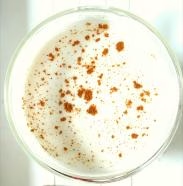When heating milk, you may sometimes notice a layer of skin rising to the surface. But why does this skin form? What is this layer? To avoid the formation of skin, there are four tips you can try when heating milk.
What is Milk skin? How is it formed?
When boiling milk, the skin that forms on the surface is often picked off, but this layer actually contains a large amount of whey protein, which is highly nutritious.
Milk is a very versatile ingredient. It imparts delicate flavors to foods and can withstand prolonged heating. The curd proteins in milk, unlike proteins in other foods, do not loosen or unfold when heated to boiling point and can withstand temperatures up to 170°C (338°F).
Milk can withstand prolonged cooking, and as it heats, new flavor molecules are continuously released, gradually revealing notes of vanilla, almonds, and cream. When milk is boiled, the sugar (lactose) and proteins in it combine, triggering the Menard reaction, which produces a rich, butterscotch flavor.
However, the whey proteins, which make up only a small amount of milk, are not heat-resistant and begin to loosen and denature at around 70°C (158°F). As milk cooks for extended periods, the heated, sticky whey proteins rise to the surface, forming a wrinkled film.
As the milk cooks longer, this film thickens and dries, eventually forming a “milk skin” on the surface. If the milk is not stirred to break this film, the temperature of the milk trapped beneath the skin will continue to rise—much like a covered pot, where boiling liquid might suddenly burst over the edge.
Once the milk skin begins to thicken and solidify, stirring alone will not break it open; it must be picked off. To avoid burnt milk and boiled milk skin, follow one or two of the following tips.
Many Benefits
The thin film that forms on the surface of soy milk when it’s boiled is removed and dried to create “yuba.” This skin is highly nutritious and can be used as a meat substitute.
How to Prevent Milk skin from Forming
Milk skin Formation:
At temperatures reaching 70°C (158°F), whey proteins unwrap and then rebind.
After unwrapping, the whey proteins aggregate and coagulate, rising to the surface of the milk to form a film.
Preventing Milk skin from Forming:
Cover the pot to prevent steam from escaping
When letting the boiled milk cool, cover the pot to trap the steam inside. The presence of steam and moisture prevents the yuba from drying out and curdling.
Use baking paper to trap steam
You can also use baking paper instead of a lid and place a circular piece of cartouche directly on the surface of the milk to prevent steam from escaping. When microwave-heating milk, you can also cut a piece of baking paper into a cup-sized circle and place it over the milk.
Break the whey proteins
Continuously stirring prevents the whey proteins from coagulating. Whisking the milk with a whisk during cooking also prevents the whey proteins from forming a film. When the milk is left to cool, the whey proteins will rise to the surface, so continue stirring.
Adding caster sugar
When making sweet custard or sweet sauces, sprinkle caster sugar on the sauce during the cooling stage. The sugar crystals prevent the whey proteins from clumping together and forming a film.


Leave a Reply